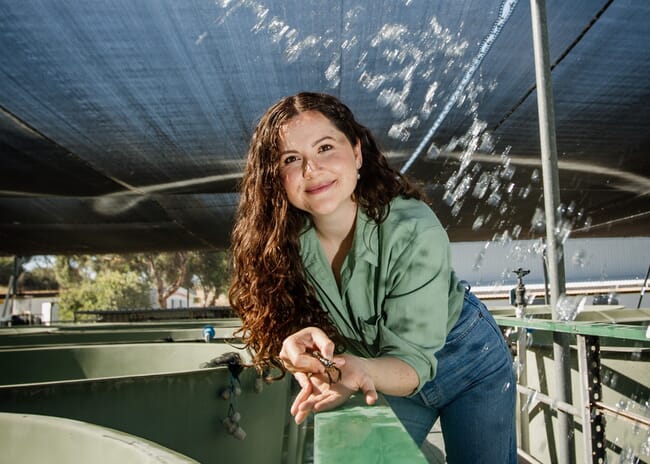
PhD candidate Isobel Sewell is investigating whether black soldier fly (BSF) larvae are a suitable alternative to fish meal for barramundi and marron © Corrina Ridgway
The University of Western Australia’s School of Biological Sciences and UWA Oceans Institute PhD candidate Isobel Sewell is investigating whether black soldier fly (BSF) larvae are a suitable alternative to fish meal in the diets of two Australian freshwater aquaculture species; barramundi and marron.
The Fisheries Research and Development Corporation-funded project is in collaboration with DPIRD and Future Green Solutions – a Perth-based BSF farm and biotechnical company.
Ms Sewell said the global production and supply of fish meal had begun to plateau over the past decade.
“Many carnivorous aquaculture species have large dietary protein requirements, often in the form of fish meal,” she said.
“Considering the aquaculture industry is the fastest-growing food production sector in the world, this becomes problematic as the supply of fish meal will be unable to meet growing demand.
“In response, we need to identify effective protein replacements to reduce dependency on marine capture fisheries.”

Sewell is quantifying the potential of a BSF larvae diet by measuring the barramundi and marron’s growth and wellbeing © Corrina Ridgway
Not only does the larvae have high protein and fat content that is comparable to fish meal, Ms Sewell said there were also significant environmental sustainability benefits.
“The larvae feed on organic waste, such as green waste and manure, which in turn is converted back into their biomass via the breakdown of protein, fats and energy,” she said.
“Because of this, they can aid in the reduction of pollution potential and greenhouse gas emissions from agricultural industries.”
Based at the UWA Shenton Park Research Station Aquaculture Facility, Ms Sewell is quantifying the potential of a BSF larvae diet by measuring the barramundi and marron’s growth and wellbeing.
“Ultimately, we have discovered that BSF larvae is viable in freshwater aquaculture diets,” she said.
“The barramundi had comparable growth rates to those on a commercial (BSF larvae-free) diet. My marron trial has produced some interesting results, suggesting the inclusion of BSF larvae promotes higher growth.”
Although further analysis of biological data is required before publishing, Ms Sewell said the results were a “good start” in creating a potential aquaculture diet.
“I hope that the results will have novel outcomes with industrial, societal, environmental and commercial impact,” she said.




